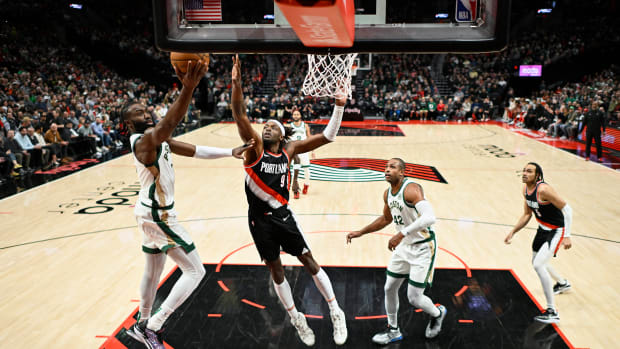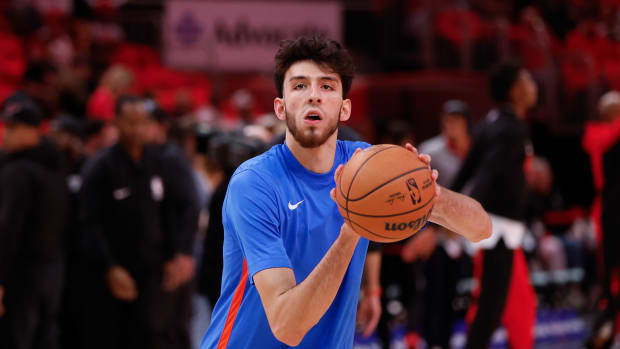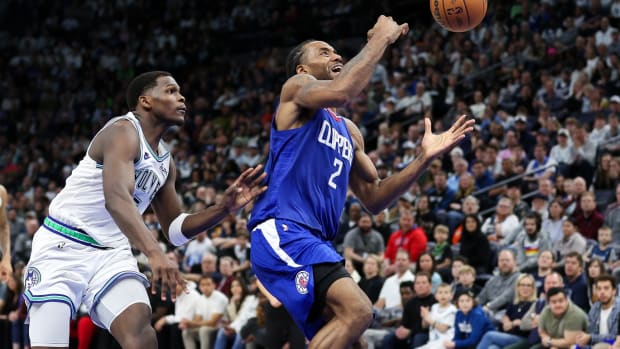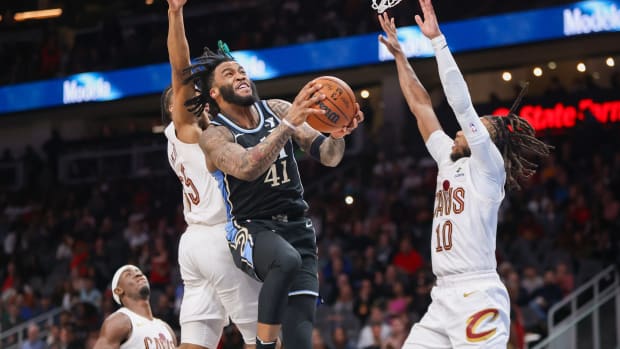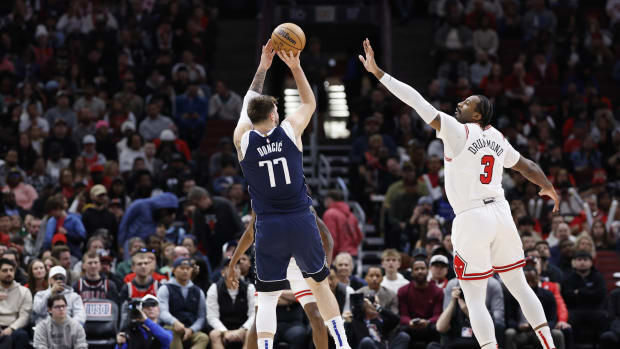Roy Hibbert rediscovers his touch from the post after battling lingering injury
A wrist injury may have been to blame for Roy Hibbert's early struggles. (Jesse D. Garrabrant/NBAE via Getty Images)
By Rob Mahoney
For months, we saw what may well be the valley of Roy Hibbert's career: good attempts with no return, a surprisingly erratic hook shot and a strangely persistent inability to convert even the simplest looks around the basket. It was all very uncharacteristic, given that the mammoth center had just months prior established himself as one of the best back-to-the-basket players in the league.
Indiana had re-signed Hibbert last summer with the expectation that he would again serve as the backbone of Indy's vaunted team defense while providing both scoring and facilitation from the low post. His struggles to finish ordinary post-up possessions or draw double teams with consistency added another layer of difficulty for a team already reeling from the absence of Danny Granger.
But things have changed a bit since this season's sour early months.
It's no coincidence that the Pacers have scored at a top-10 rate since the All-Star break and, essentially, since Hibbert's touch returned. Paul George and David West held over Indiana in the interim (and continue to do the bulk of the offensive creation for the Pacers, who sit third in the East at 48-27), but a fully operational Hibbert has done wonders for Indiana's balance and ball movement.
A 7-footer with an established post game naturally draws in defenders with every move and every dribble, and those teams that refuse to swarm Hibbert in the post now run the risk of him simply backing down his man and dropping in an easy hook. In a league increasingly wary of surrendering open three-pointers, that happens more often than you'd think. Hibbert has scored 19.5 points per 36 minutes on an incredibly sound 50.4 percent shooting since the NBA's intermission. Prior to the break, Hibbert was putting up just 12.6 points per 36 while shooting just 41.4 percent from the field -- woeful marks for any interior player, and especially one of Hibbert's skills and pay grade.
Yet the most fascinating aspect of Hibbert's performance is how little has actually changed. There's no meaningful difference in terms of the quality or nature of Hibbert's attempts, and there was no discernible shift in terms of his shooting form or positioning. Hibbert simply endured the worst shooting slump of his career as if it were a bad storm -- torrential and damaging, sure, but limited by its inevitable passing. The skies are clearer now, but neither Hibbert nor any of the principles involved seem to have any idea what dictated the comings or goings of his struggle. From Kevin Arnovitz of ESPN.com:
Ask [Hibbert], his coach or his teammates where anything has changed about his form or mechanics, and all you get are shrugs. So what's Hibbert doing now that he wasn't at the start of the season? "The tougher question is, 'Why wasn’t he finishing before?'" Pacers coach Frank Vogel said. "What he’s doing now is what we’ve come to expect." Hibbert led all scorers on Monday night, recording 26 points on 11-for-14 shooting from the field. Hibbert offered his own theories: "Don't force things," he said. "I come in on my days off and try to get better. I try to mimic David West's workouts." Vogel offered another theory prior to the game. When Hibbert couldn't buy buckets earlier in the season, Vogel encouraged the center to focus on anchoring the defense. Sure, be mindful of opportunities on the other end, but do it with less deliberate effort and more in the flow of the offense.
That guesswork on the part of Hibbert and Vogel ultimately isn't that satisfying, and it does little in the way of drawing us toward any real conclusions. But this is one matter in which we may simply have to be content with the unexplained.
A deep dive into the tape shows more or less the same Hibbert through struggles and successes, save perhaps the slightest hesitation as the misses began piling up. That said, we can find the slightest indication of a very relevant injury, as Hibbert described a certain flimsiness in his wrist to Mike Wells of the Indianapolis Star a few months back for a report that is no longer online (excerpt via 8p9s):
"I haven't had any power in my right wrist, so my hand has been basically a stub...It doesn't hurt. It just has weakness. Things were just out of whack. I was getting the shots I wanted with my right hand, but a few would go completely off track. So my touch was basically gone. That's why I was shooting more shots with my left hand in the post."
Hibbert doesn't often mention the ailment and I've seen no evidence of Vogel or any other Pacer citing Hibbert's injury as an excuse. But it could help explain Hibbert's early season struggles and justify why so many of Hibbert's post-up attempts took odd angles or bounces after leaving his hand in the season's early going. To explore that notion, let's take a look at Hibbert's shot chart from the 53 games prior to the All-Star break:
Take note of the glaring swath of red on the right block, where Hibbert went 9-of-35 overall. Many right-handed post players prefer to work from the left block because it allows them to go middle more naturally, but Hibbert has a tendency to push middle before countering baseline for a hook shot. That means the shots he's attempting from the right side of the floor -- as in that 9-of-35 zone -- are largely attempted with the right hand, while those on the left were primarily lefty hooks or face-up set shots. There were also a number of occasions in which Hibbert noticeably went away from potential scoring opportunities with his right while working from the middle of the floor -- an occurrence that certainly jives with the weakness he would later describe to Wells.
For contrast, let's look at Hibbert's shooting in the 21 games since the break:
Hibbert's shooting from the left side of the lane has more or less held constant, all while his shooting from the right block has improved by nearly 20 percent. The overall number of attempts from the right and left are also sliding toward equilibrium, after Hibbert noticeably favored the left earlier in the year, taking almost twice as many attempts from that side of the block. Considering the circumstances, this may be as closest thing to definitive evidence that we're likely to see, even if it's merely based on an underplayed injury. Still, Hibbert's weak wrist may too help to explain some of his difficulty in finishing looks in the immediate basket area early in the season -- a trend which seems to have been bucked with his much-improved shooting at the rim over the last few months.
It's a bit strange that Hibbert's wrist injury hasn't been a bigger component of the conversation surrounding his struggles, but information on the matter has been strangely limited and Hibbert himself even seems reluctant to mention it. Still, this may be the most grounded way to make sense of what had been a baffling stretch of basketball for a normally impressive player.
Statistical support for this post provided by NBA.com.


































